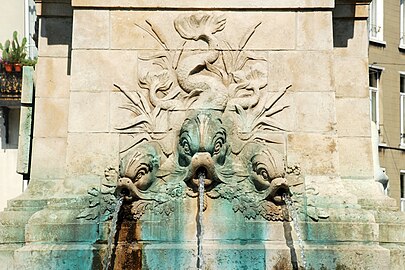Anspach Fountain
 | |
 | |
| 50°51′13″N 4°20′49″E / 50.85361°N 4.34694°E | |
| Location | Square des Blindés / Pantsertroepensquare B-1000 City of Brussels, Brussels-Capital Region, Belgium |
|---|---|
| Designer | Charles-Émile Janlet |
| Type | Fountain |
| Completion date | 1897 |
| Dedicated to | Jules Anspach |
The Anspach Fountain (French: Fontaine Anspach, Dutch: Anspachfontein) is an eclectic-style fountain-obelisk erected in 1897 in the centre of the Place de Brouckère/De Brouckèreplein in Brussels, Belgium. Designed by the architect Charles-Émile Janlet, it is dedicated to the memory of Jules Anspach, a former mayor of the City of Brussels.[1][2]
The monument was dismantled in 1973 following construction work on the Brussels Metro.[1] It was reinstalled in 1981 in its current location on the Square des Blindés/Pantsertroepensquare, between the Quai aux Briques/Baksteenkaai and the Quai au Bois à Brûler/Brandhoutkaai, in the Sainte-Catherine/Sint Katelijne neighbourhood.[3][2]
History
The Anspach Fountain was designed by the architect Charles-Émile Janlet and erected in 1897 in the centre of the Place de Brouckère/De Brouckèreplein, left empty by the destruction of the former Temple of the Augustinians.[4] The fountain pays homage to Jules Anspach, mayor of the City of Brussels from 1863 to 1879, as well as promoter of the covering of the river Senne (1867–1871) and the creation of the Central Boulevards.[1][2] This monument stood exactly in the axis of the Boulevard Anspach/Anspachlaan, like a regulator of traffic at the birth of the fork between the Boulevard Émile Jacqmain/Émile Jacqmainlaan and the Boulevard Adolphe Max/Adolphe Maxlaan. It was considered in its time the most beautiful and the grandest in the city.[1]

The fountain was removed in 1973 to make way for access to De Brouckère metro station.[1] The authorities had promised to put it back in place after the works, but it was eventually reinstalled in May 1981 in a basin that occupies the space between the Quai aux Briques/Baksteenkaai and the Quai au Bois à Brûler/Brandhoutkaai, in the Sainte-Catherine/Sint Katelijne neighbourhood, some 700 metres (2,300 ft) from the Place de Brouckère.[3][2]
Description
The eclectic-style monument, 20 metres (66 ft) high,[1] is made up of a Swedish granite obelisk surmounting a blue stone pedestal surrounded by a basin.[2] Inseparable from the monumental perspective of the boulevards—and yet moved following the works of the metro—it is, through its dedication and former location, a tribute to Anspach.[2]
Pedestal
The blue stone pedestal, decorated with a marble bas-relief depicting an allegory of The Covering of the Senne, the work of the sculptor Paul De Vigne, and chimeras sculpted by Godefroid Devreese,[3] is surrounded by a four-lobed basin decorated with mascaron spitters made by the sculptor Pierre-Jean Braecke. On the pedestal, there are also inscriptions recalling the names of the artists and the circumstances of the monument's construction.[1]
Obelisk
The pink granite obelisk bears at its base a white marble medallion with Anspach's image by Paul De Vigne, surrounded by bronze allegories of The Municipal Judiciary and the The Grateful City of Brussels by the sculptor Julien Dillens.[1][3] The top of the obelisk bears a bronze ornament made by Pierre Braecke depicting a fortified castle surmounted by a Gothic spire decorated with finials and ending with an effigy of Saint Michael, the patron saint of the City of Brussels, slaying a dragon or demon.[1][3]
-
Statue of Saint Michael slaying the dragon by Pierre-Jean Braecke
-
The Municipal Judiciary by Julien Dillens
-
The Grateful City of Brussels by Dillens
See also
References
Notes
Bibliography
- Demey, Thierry (1990). Bruxelles, chronique d'une capitale en chantier (in French). Vol. I: Du voûtement de la Senne à la jonction Nord-Midi. Brussels: Paul Legrain/CFC. OCLC 44643865.
- Eggericx, Laure (1997). Les Boulevards du Centre. Bruxelles, ville d'Art et d'Histoire (in French). Vol. 20. Brussels: Centre d'information, de Documentation et d'Etude du Patrimoine.
- Loze, Pierre; Vautier, Dominique; Vestre, Marina (1990). Guide de Bruxelles XIXème et Art Nouveau (in French). Brussels: Eiffel Editions - CFC Éditions.
- Le Patrimoine monumental de la Belgique: Bruxelles (PDF) (in French). Vol. 1A: Pentagone A-D. Liège: Pierre Mardaga. 1989.



![Mascaron by Pierre-Jean Braecke [fr]](http://upload.wikimedia.org/wikipedia/commons/thumb/4/45/Belgique_-_Bruxelles_-_Fontaine_Anspach_-_12.jpg/180px-Belgique_-_Bruxelles_-_Fontaine_Anspach_-_12.jpg)
![Statue of Saint Michael slaying the dragon by Pierre-Jean Braecke [fr]](http://upload.wikimedia.org/wikipedia/commons/thumb/f/f8/Belgique_-_Bruxelles_-_Fontaine_Anspach_-_07.jpg/200px-Belgique_-_Bruxelles_-_Fontaine_Anspach_-_07.jpg)


